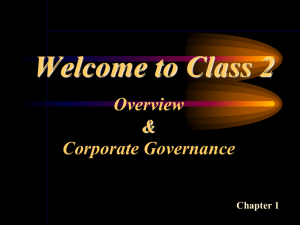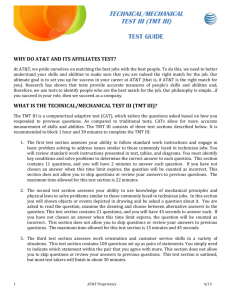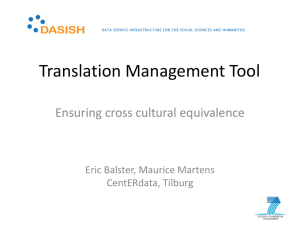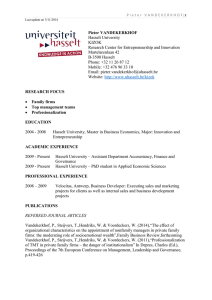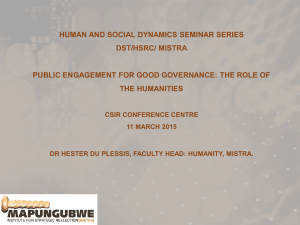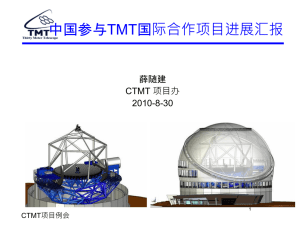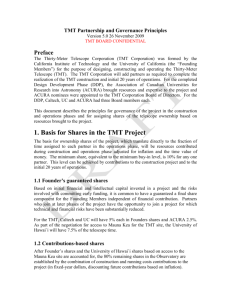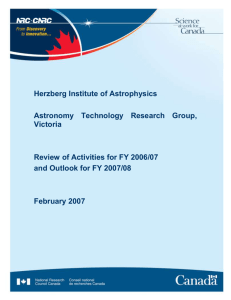Class2
advertisement
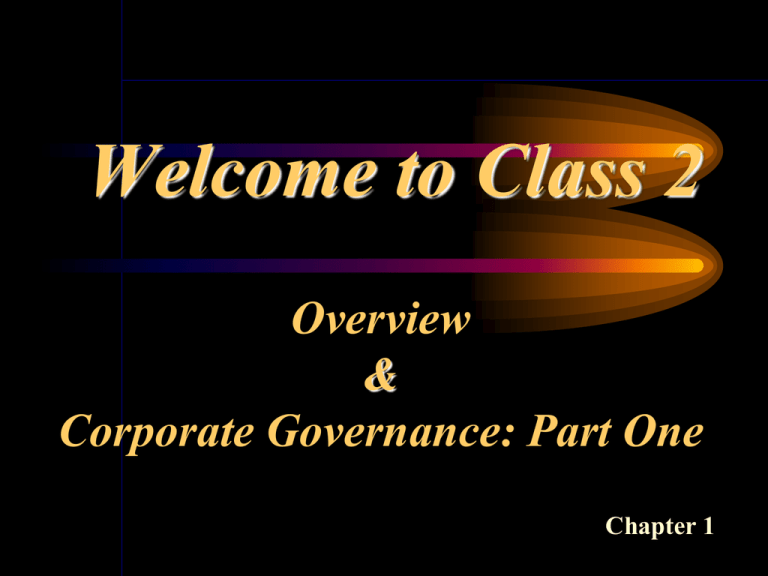
Welcome to Class 2 Overview & Corporate Governance: Part One Chapter 1 Overview of Course & Textbook Course is divided into Concepts and Activities Concepts are divided into Management issues and Strategy issues Activities are divided into Research and Evaluation The Management book presents TMT Competencies, Strategy Concepts, and Methods for Researching and Assessing Corporate Performance Book available only as an “E” book: Management Strategy & Performance Online: http://www.campus-hq.com/ Research, Analyze, and Report Raymond K. Van Ness 5th Edition The Management Textbook is divided into three distinct segments Governance & Nature of Strategy Nature of Corporate Performance Demystification of Financial Data; Measuring, Assessing, & Reporting Top Management Teams (TMT) (1) Introduction to Corporate Research (5) Stakeholder Perspective (9) Business Environments (2) Research Methodologies (6) Creating Value (3) Corporate Boards (4) Ch 1, 2, 3, 4 Financial Demystification (10) Performance Scorecard (11) Qualitative Research (7) Measurements & Meanings (12) Financial Research (8) Performance Scoring & Report Drafting (13) Formalizing The Performance Report (14) Ch 5, 6, 7, 8 Ch 9,10, 11,12, 13,14 Each Chapter addresses specific questions Chapter 1: Who is running the company and what should they know and do? Chapter 2: What is the business climate and what must firms do to compete successfully? Chapter 3: How do firms add value & whom must they satisfy? Chapter 4: What are the mechanisms for overseeing TMT behavior and decision-making? Chapter 5: What is corporate research? Chapter 6: How can “we” do corporate research and why is it important? Chapter 7: How do “we” research the social side of performance & TMT’s strategic planning? Chapter 8: What do “we” need to know to investigate financial performance? Each Chapter addresses specific questions Chapter 9: Why do different people assess a firm’s performance differently? Chapter 10: Why are financial reports confusing and how can they be made understandable? Chapter 11: What is a functional tool for standardizing financial reports? Chapter 12: What do all the ratios mean and how can they be used effectively? Chapter 13: What is an easy and effective way of quantifying a firm’s performance? Chapter 14: What is an easy and effective way for reporting a firm’s performance? Each person must purchase their own individual online text & analysis software. You MUST have your own copy. Management Strategy & Performance Research, Analyze, and Report Raymond K. Van Ness 5th Edition Note: A security code will be provided by the publisher that MUST be included on your final semester project. The PSC software will be provided by the publisher when you acquire your online textbook package. A Closer look …. Corporate Governance Corporate Governance The success or failure of any organization is dependent upon a number of factors but none is more important than its governance and its governing body Effective corporate governance Balances the interests of : Customers, employees, managers, owners, and other stakeholders of the firm The governing body consists of: Stockholders, Management, & Board of Directors Governance: Issues and Concerns (Continued) Corporate Governance = the processes, customs, policies, and procedures of a firm as well as the governing body that is responsible for its direction, management, and control. The governing body of a firm includes a combination of Top Management Teams (TMT) and the board of directors but… in most instances the TMT dominates the entire decisionmaking process. Corporate Governance Leadership Processes Procedures Corporate Governance Policies Customs Governance: Anchor Points The anchor points for corporate governance and the strategies for planning, directing, and controlling the firm are identified in the organization's vision and mission statements. A firm's vision, mission, and strategy are symbiotic and dynamic. • VMS is an abbreviation for a firm’s Vision, Mission, & Strategy Vision-Mission-Strategy Vision VMS Strategy Mission Vision and Mission The Vision and Mission statements of a corporation are important anchors that communicate "what a firm wants to be" and "what the firm does." These anchors provide a stable identity analogous to a nation's constitution. They are an expression of a firm’s values and beliefs about its responsibility as a corporate citizen. They clarify the purpose of the organization, help employees bond with the firm, and set a context for understanding management decisions and actions. Vision A Vision Statement should be inspiring and highlight a firm's aspirations and values. It should be uplifting and evoke positive emotions. It defines "what a firm wants to be." Mission The firm's mission statement clarifies where the firm will focus its attention and highlights its core values and beliefs. It may emphasize how and why the company plans to compete in specific areas. In brief, it clarifies "what a firm does." Strategy A firm's strategy is the TMTs "how to" plan for fulfilling the organization's mission and accomplishing its goals and objectives. A firm's strategic plan is an extremely detailed document outlining specific courses of action each with precision and an exact timeline. It is the map for achieving competitiveness. It emphasizes its Performance Objectives Performance Objectives TMTs guide their firms to the achievement of Performance Objectives by: Motivating the firm's employees Energizing & leveraging value-producing resources Developing basic, core, and distinctive competencies Performance Objective Ladder 1 2 3 • Strategic Competitiveness (Initial Competitive Advantage) • Sustainable Competitive Advantage • Recurrent Above Average Returns 1. Strategic Competitiveness Strategic Competitiveness is the result of unique business competencies that enable the firm to perform activities more effectively and efficiently than rivals. It is the first rung on the performance objective ladder It means the firm is able to earn disproportionally higher profits than its competitors. It suggests a firm has a competitive advantage over rival firms. 2. Sustainable Competitive Advantage Achieving a Sustainable Competitive Advantage means a firm has discovered a method for continuously performing its value generating activities more effectively and efficiently than its rivals. Sustainable competitive advantage is the second rung on the competitive ladder – it means "commercial staying power." 3. Recurrent Above Average Returns [RAAR] Above Average Returns are desirable to investors since they indicate the firm is a better than "average" investment. Above average returns are those that exceed what investors would normally expect to achieve on similar risk investments. The ultimate objective is to implement a strategy that enables these AAR to be recurrent. RAAR is the third rung on the performance objective ladder. Recurrent Above Average Returns are earned only by firms that have ACHIEVED and SUSTAINED a competitive advantage for an extended period of time. Remember: Sustainable = Recurrent Potential Sustained = Recurrent Achievements Above Average Returns & Strategic Levels Competitive Advantage, Above Average Returns, and Strategic Levels BUSINESS level: Competitive Advantage and above average returns at the “business” strategic level = high profits + satisfied customers. CONGLOMERATE level: Competitive Advantage and Above Average Returns at the “conglomerate” strategic level = successful & synergistic subsidiary businesses. (Portfolio of businesses) Conglomerate level strategy is also called corporate level strategy Performance: Theoretical Models Performance: Theoretical Models Conflicting Theories about The Primary Factors Dictating a Firm’s Success or Failure In achieving RAAR Is Performance primarily dependent upon a firm’s competencies and leadership? Or Is Performance primarily related to the industry in which a firm competes? The conflicting ideas are categorized as: (1) The Resource-based View, and (2) The Industry/Organizational View (1) Resource-based View (R/B Model) The resource-based view assumes that management competency combined with a unique set of firm resources and capabilities = the chief determinant in the ability to provide above average returns to investors. A firm’s physical, financial, intangible, intellectual, and leadership resources will determine the degree of its success. Under the R/B Model, assessments of conditions and situations in the internal environment assume paramount importance to strategic planning. (1) Resource-based View (Cont) Assumptions of the R/B model: 1. Strategies are dictated by the firm’s unique resources and capabilities 2. Strategies should include searching for an environment in which the firm’s resources and capabilities can be appropriately exploited. In other words, it is not so much the industry that dictates the firm’s ability to produce above average returns as it is the ability to compete within that industry. (2) Industry/Organizational View (I/O Model) The industry/organizational view assumes the industry in which a firm competes = the primary determinant in the ability to grow and provide above average returns to investors. Although a firm’s physical, financial, intangible, intellectual, and leadership resources are important, it is primarily the industry in which it competes that will determine the degree of its success Under the I/O Model, assessments of conditions and situations in the external environment assume paramount importance in strategic planning. I/O Model (Cont) Assumptions of the I/O model: 1. External environment imposes pressures and constraints that determine strategies leading to above-average returns 2. Most firms competing in an industry control similar strategically relevant resources and pursue similar strategies 3. Resources used to implement strategies are highly mobile across firms 4. Organizational decision makers are assumed to be rational and committed to acting in the firm’s best interests (profitmaximizing) TMT – Competencies From the R/B Model to the I/O Model Competent TMTs are essential Skills Knowledge Ability Managerial Competence Literacy = Knowledge [Understand Concepts] Managerial literacy at the TMT level suggests a highly refined knowledge of managing people and strategies. TMT literacy encompasses knowledge of contemporary theories and practices for the effective deployment of intellectual, physical, and financial resources. TMTs are expected to have an extensive knowledge of corporate finance and accounting. 8 Specific spheres of business literacy • • • • • (1) Human resources (2) Corporate cultures (3) Industry-specific customs, practices, and procedures (4) Accounting and finance (5) Techniques for the effective utilization of corporate resources • (6) Systems for assessing progress (qualitative and financial performance monitors) • (7) Analysis methods (feedback loops) • (8) Tactical and Strategic planning Manage = Skills [Can Apply Concepts] Management skills or skills-set refers to the technical know-how and the degree of proficiency with the three methods of persuasion. The TMT must be able to apply what they know – there are many business managers who are considered “knowledgeable" yet they are ineffective. Inept leaders often have theoretical knowledge but are lacking in one or more of the following management skills: 1. Communication Skills 2. Implementation Skills 3. Interpersonal Skills 4. Persuasion Skills Skills of Persuasion Management skills or skills-sets refer to both technical competence and skills of persuasion. Good managers must not only demonstrate their knowledge but also master the skills of persuasion. Aristotle, the Greek philosopher, identified three methods of persuasion and good managers have mastered each: • Logos = Persuasion by reasoning • Pathos = Persuasion by emotional appeal • Ethos = Persuasion by Character • In other words, even though an individual may be business literate at the highest level, if they cannot persuade, they have not achieved the minimum level of necessary administrative skills. Logos Ethos Pathos Ability = Critical Thinking [Can Apply Concepts with great expertise] Critical thinking is the intellectual disciplined process of eliminating bias as one conceptualizes, synthesizes, analyzes, and evaluates information gathered by observation and/or experience. It involves a process of visualizing situations from a variety of perspectives and reflecting, reasoning, and communicating conclusions in clear and logical manner. It is a process where clarity, accuracy, and consistency are priorities while prejudice and data distortion are guarded against as conclusions are carefully reasoned and precisely communicated. 10 dimensions to Critical Thinking: 1. Depth 2. Breadth 3. Precision 4. Consistency 5. Relevance 6. Sound evidence 7. Good reasoning 8. Clarity 9. Accuracy 10. Fairness Summary of KSAs Knowledge = Literacy The degree to which the TMT demonstrates its knowledge and understanding of the hierarchical dimensions of business including theoretical, technical, financial, and managerial aspects Skill = Manage/Administrate Management skills or skills-set: The degree to which TMTs have mastery of the three primary skills of persuasion. Ability = Critical Thinking The degree to which the TMT demonstrates the ability to think quickly and critically. It is their ability to contemplate the probable consequences of decisions and envision action-alternatives. They can objectively contemplate, deliberate, and evaluate situations, conditions, and achievements. End Corporate Governance: Part One To Be Continued in Class 3: TMT Responsibilities, SWOT Analyses, Strategic Intent, Formulation, Implementation, and Management Homework: (1) Re-Read Chapter 1 in your online textbook (2) Elect Team Officers: -- President --Vice President -- Secretary
